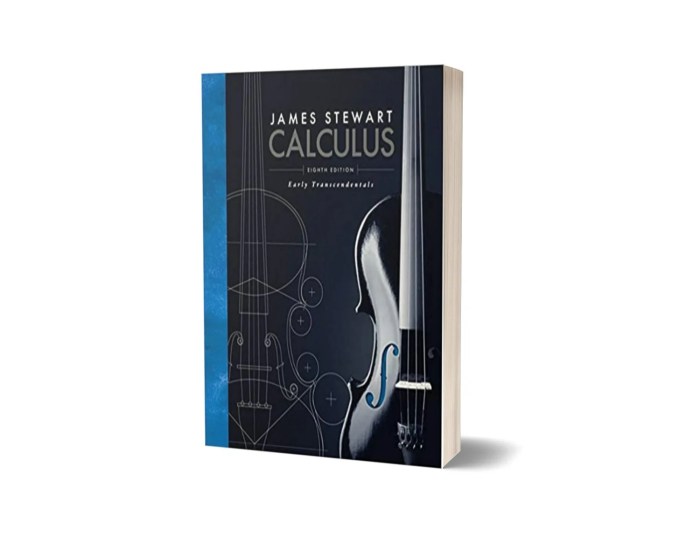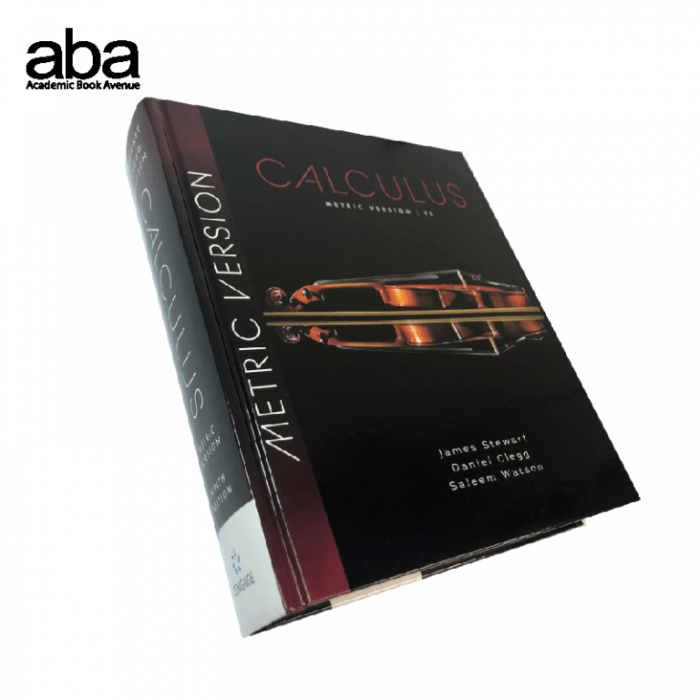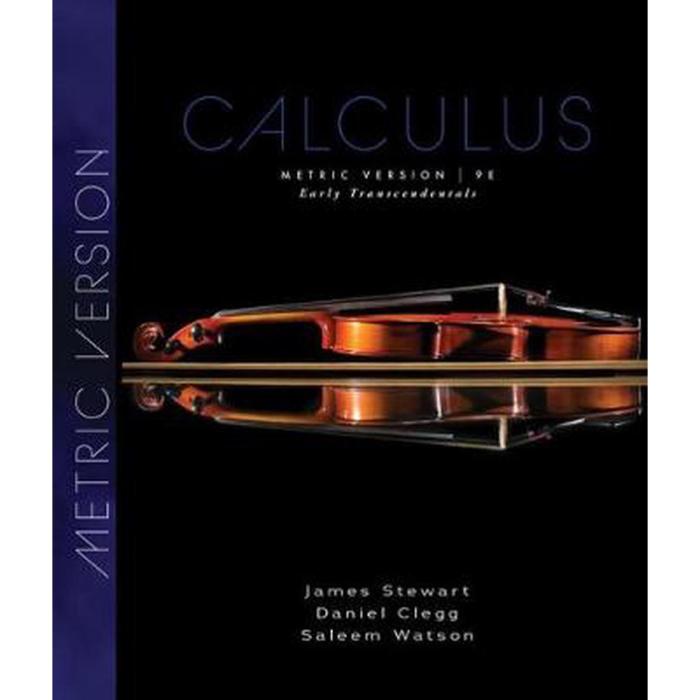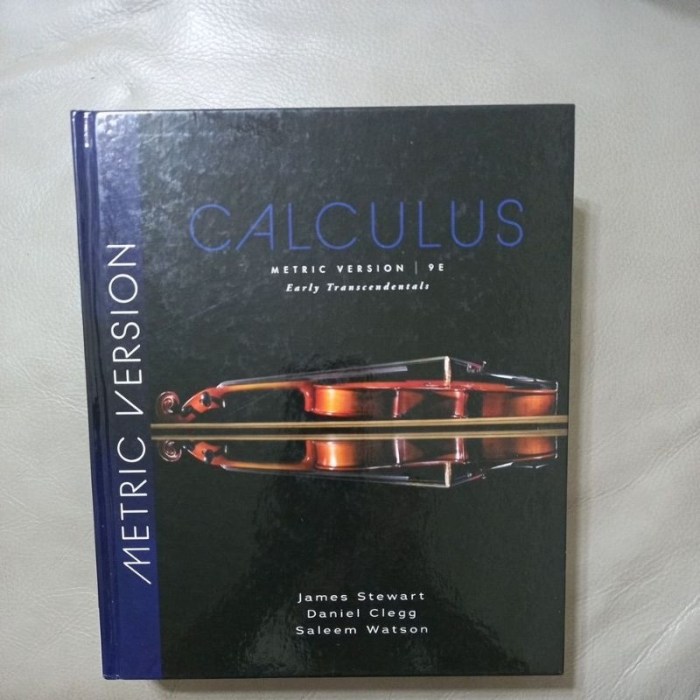Embark on a mathematical journey with Calculus by Stewart 9th Edition, a comprehensive guide that unlocks the intricacies of calculus for students and professionals alike. Its accessible approach and innovative pedagogical features empower learners to grasp complex concepts with ease.
This textbook has revolutionized calculus education, providing a solid foundation for understanding the fundamental principles of calculus and their applications in various fields.
Calculus by Stewart 9th Edition Overview

The ninth edition of Calculus by Stewart continues the legacy of providing an accessible and comprehensive introduction to the field of calculus. This edition retains the hallmarks of the Stewart series, including its clear and engaging writing style, meticulous attention to detail, and wide range of resources.
The 9th edition has been updated to reflect the latest developments in calculus education, including the use of technology and the incorporation of real-world applications. It is designed for students in a wide range of disciplines, including mathematics, science, engineering, and business.
Target Audience
Calculus by Stewart 9th Edition is intended for students who are new to calculus or who need a review of the subject. It is suitable for both high school and college students, as well as for self-learners.
Key Features
- Clear and engaging writing style
- Meticulous attention to detail
- Wide range of resources, including online homework, tutorials, and videos
- Updated to reflect the latest developments in calculus education
- Incorporation of real-world applications
Significance
Calculus by Stewart 9th Edition is a valuable resource for students learning calculus. It provides a solid foundation in the subject and prepares students for further study in mathematics and related fields.
Pedagogical Features

Calculus by Stewart 9th Edition incorporates various pedagogical features to enhance student learning and engagement. These features are designed to provide a structured and supportive learning environment that fosters understanding and critical thinking.
The pedagogical features employed in the textbook can be categorized into three main types: visual aids, interactive elements, and assessment tools.
Visual Aids
Visual aids play a crucial role in Calculus by Stewart 9th Edition. The textbook includes numerous graphs, diagrams, and illustrations that help students visualize complex concepts and make connections between different mathematical ideas.
- Interactive Figures:The textbook features interactive figures that allow students to manipulate graphs and diagrams to explore different scenarios and observe the effects of changing variables.
- Concept Checks:These brief quizzes are interspersed throughout the chapters to provide students with immediate feedback on their understanding of key concepts.
- Worked Examples:The textbook provides numerous worked examples that demonstrate how to solve problems step-by-step, helping students develop their problem-solving skills.
Interactive Elements
Calculus by Stewart 9th Edition also includes interactive elements that encourage student engagement and active learning.
- Online Homework Assignments:The textbook comes with access to online homework assignments that provide students with practice problems and immediate feedback on their answers.
- WebAssign:This online platform offers interactive exercises, videos, and simulations that help students reinforce their understanding of the material.
- Study Guide:The study guide provides additional practice problems and review questions to help students prepare for exams.
Assessment Tools
Calculus by Stewart 9th Edition includes a variety of assessment tools to help students track their progress and identify areas for improvement.
- Chapter Quizzes:Each chapter concludes with a quiz that assesses students’ understanding of the material covered in the chapter.
- Midterm and Final Exams:The textbook provides sample midterm and final exams to help students prepare for these assessments.
- Practice Exams:The textbook also includes practice exams that allow students to simulate the experience of taking a real exam.
Problem-Solving Techniques

Calculus by Stewart 9th edition presents a comprehensive approach to problem-solving in calculus. The textbook introduces a step-by-step method that guides students through the process of analyzing and solving calculus problems effectively.
The problem-solving techniques emphasized in the textbook include:
- Understanding the Problem:Reading the problem carefully, identifying the given information, and determining what is being asked.
- Devising a Plan:Selecting appropriate techniques or formulas to solve the problem, considering different approaches.
- Carrying Out the Plan:Applying the chosen techniques and formulas, showing all steps and calculations.
- Looking Back:Checking the solution, verifying if it makes sense and satisfies the problem’s conditions.
Step-by-Step Approach, Calculus by stewart 9th edition
The step-by-step approach to problem-solving is a fundamental aspect of Calculus by Stewart 9th edition. This approach helps students break down complex problems into smaller, manageable steps, making the process more accessible and less overwhelming.
- Read the problem carefully:Understand the given information and what is being asked.
- Identify the relevant concepts:Determine which calculus concepts are applicable to the problem.
- Choose a strategy:Select appropriate techniques or formulas to solve the problem.
- Carry out the solution:Apply the chosen strategy, showing all steps and calculations.
- Check your answer:Verify if the solution is reasonable and satisfies the problem’s conditions.
Problem-Solving Strategies
Calculus by Stewart 9th edition also introduces various problem-solving strategies that help students develop a deeper understanding of calculus concepts and improve their problem-solving skills.
- Graphical Approach:Using graphs to visualize the problem and find solutions.
- Numerical Approach:Using numerical methods, such as tables or approximations, to solve problems.
- Analytical Approach:Using algebraic or trigonometric techniques to solve problems.
- Heuristic Approach:Using educated guesses or trial-and-error methods to find solutions.
Applications of Calculus

Calculus is a powerful tool with a wide range of applications in various fields, from science and engineering to economics and finance. Calculus by Stewart 9th edition comprehensively covers these applications, providing students with a deep understanding of how calculus concepts are used to solve real-world problems.The
textbook seamlessly integrates these applications into its content, ensuring students grasp the practical relevance of the material they are learning. Throughout the book, numerous examples and exercises illustrate how calculus is used in various fields.
Applications in Physics
Calculus plays a crucial role in physics, enabling scientists and engineers to analyze and solve complex problems involving motion, forces, and energy. Calculus concepts such as derivatives and integrals are essential for understanding and predicting the behavior of physical systems.For
instance, calculus is used to determine the velocity and acceleration of objects in motion, calculate the area under a curve representing displacement over time, and analyze the forces acting on a body.
Applications in Engineering
Calculus is indispensable in engineering disciplines, providing engineers with the mathematical tools to design and analyze structures, machines, and systems. Calculus concepts are used to optimize designs, analyze stresses and strains, and model complex physical phenomena.Examples include using calculus to calculate the volume of a storage tank, determine the optimal shape of a bridge, or analyze the flow of fluids in a pipe.
Applications in Economics and Finance
Calculus is extensively used in economics and finance to model and analyze economic phenomena such as supply and demand, market equilibrium, and investment strategies. Calculus concepts like derivatives and integrals are essential for understanding and predicting economic trends.For instance, calculus is used to determine the marginal cost of production, calculate the present value of an investment, or analyze the risk-return trade-off in portfolio management.
Applications in Biology and Medicine
Calculus is increasingly used in biology and medicine to model and analyze complex biological systems and medical data. Calculus concepts such as differential equations and optimization techniques are essential for understanding and predicting the behavior of living organisms and developing new medical treatments.Examples
Calculus by Stewart 9th edition is a great resource for students who are looking to learn more about calculus. The book is well-written and easy to understand, and it provides plenty of practice problems to help students master the material.
In addition to calculus, the book also covers a variety of other topics, including birds of east texas piney woods . This section of the book is a great resource for students who are interested in learning more about the birds that live in this region of the United States.
The book provides information on the different types of birds that live in the piney woods, as well as their habitats and behaviors. Calculus by Stewart 9th edition is a valuable resource for students who are looking to learn more about calculus and other related topics.
include using calculus to model the growth of bacteria populations, analyze the spread of diseases, or optimize drug delivery systems.
Illustrations and Visual Aids: Calculus By Stewart 9th Edition

Calculus by Stewart 9th Edition employs a comprehensive suite of illustrations, graphs, and other visual aids to enhance comprehension and clarify complex mathematical concepts. These visual elements serve as invaluable tools for students, aiding in the visualization and understanding of abstract ideas.
Illustrations
The textbook features a wealth of high-quality illustrations that depict mathematical concepts in a clear and visually appealing manner. These illustrations are meticulously crafted to capture the essence of the mathematical principles they represent, making them easy to understand and remember.
For instance, the book utilizes illustrations to demonstrate the behavior of functions, the relationships between different curves, and the geometry of surfaces.
Graphs
Graphs play a crucial role in Calculus by Stewart 9th Edition. The book extensively uses graphs to illustrate the behavior of functions and their derivatives. These graphs provide a visual representation of the mathematical relationships being studied, enabling students to grasp the concepts more intuitively.
Moreover, the graphs help students identify key features of functions, such as intercepts, extrema, and points of inflection.
Other Visual Aids
Beyond illustrations and graphs, the textbook incorporates a range of other visual aids to support learning. These include tables, charts, and diagrams. Tables are used to organize and present data, while charts provide a visual summary of key information. Diagrams are particularly useful for representing complex relationships and processes.
For example, the book uses diagrams to illustrate the chain rule, the inverse function theorem, and the concept of a vector field.
Common Queries
Is Calculus by Stewart 9th Edition suitable for beginners?
Yes, its accessible writing style and clear explanations make it an excellent choice for students encountering calculus for the first time.
What are the key features of Calculus by Stewart 9th Edition?
Interactive online resources, practice exercises, and real-world applications enhance the learning experience.
How does Calculus by Stewart 9th Edition approach problem-solving?
It emphasizes a step-by-step approach, providing detailed explanations and worked-out examples to guide students through complex problems.